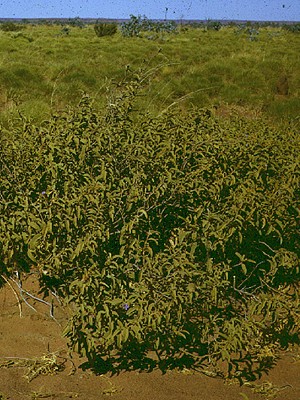
Synonymy
Solanum dioicum W. Fitzg., J. & Proc. Roy. Soc. W. Austral. 3: 104, 203 (1918)
T: Dillons Springs, East Kimberley, W.A., Oct. 1906, W.V. Fitzgerald s.n.; holo: NSW; iso: AD ex ADW, BM, E.
An image of the isotype in BM can be seen on the Solanaceae Source site.
Description
Erect or spreading clonal shrub to 1 m, usually male or bisexual; grey-green, rusty-green or silvery, densely pubescent with stellate hairs; prickles 5-10 mm long, often pubescent towards base, usually common on stems and calyx-tube of bisexual flower, few or absent elsewhere.
Leaves ovate, ovate-lanceolate or elliptic; lamina mostly 6-10 cm long, 10-30 cm wide, sometimes larger, usually concolorous, petiole 1-2 cm long.
Male plant: inflorescence up to 20-flowered; peduncle to 1 cm long; rachis 2-10 cm long, pedicels 5-7 mm long; calyx 4-6 mm long, the lobes broadly triangular with linear apices, 1-2 mm long; corolla shallowly campanulate-rotate, 2-3 cm diam., purple; anthers 3-5 mm long. Female plant: flowers solitary; peduncle absent or to 2 mm long; pedicel 5-8 mm long; calyx 15-27 mm long, enlarged in fruit, the lobes linear, 10-20 mm long; corolla broadly stellate, 30-50 mm diam., purple; anthers c. 5 mm long.
Fruiting pedicel 10-30 mm long; fruiting calyx 25-30 mm diam. Berry globular, 20-30 mm diam., yellow-green when ripe, drying pale brown. Seeds 2-2.5(3) mm long, black or very dark brown. n=12, 24.
Distribution and ecology
Occurs from Port Hedland, north-western W.A., through the Kimberley to north-western N.T.
Grows on sand plains, alluvial flats, and rocky outcrops. Usually associated with hummock grassland and open woodland.
Relationships
All of the dioecious members of the Dioicum group of subgen. Leptostemonum exhibit functional dioecy i.e. male flowers are borne on separate plants from what appear to be plants with bisexual or hermaphrodite flowers; while these bisexual flowers do produce pollen, it is inaperturate and does not germinate, making the flowers effectively female (Knapp et al.,1998).
Initial molecular studies by Martine et al. (2006) suggested that the two functionally dioecious species from Kakadu, S. asymmetriphyllum and the newly described S. sejunctum, formed a separate clade and had arisen separately from the other dioecious members of the Dioicum group, S. cunninghamii, S. cataphractum , S. dioicum, S. petraeum, S. carduiforme, S. tudununggae, S. vansittartense and S. leopoldense. T his initial DNA analysis involved sequencing of the ITS region of nuclear rDNA.
However further molecular analysis involving the trnK-matK gene region indicated that all of the functionally dioecious species form a single clade arising from the andromononoecious species of the group (Martine et al., 2009).
Many of these dioecious species remain undercollected and poorly understood and it is likely that some of these names will be changed with further work. 12 collections of S. dioicum included in the initial DNA analysis (Martine et al. 2006) showed considerable variation within the clade and it is likely that this is not a single species as presently constituted.
References: S.Knapp, V.Persson & S.Blackmore (1998). Pollen morphology and functional dioecy in Solanum (Solanaceae). Pl. Syst. Evol. 210:113-139.; Martine, C.T., D. Vanderpool, G.J. Anderson, and D.H. Les (2006). Phylogenetic relationships of andromonoecious and dioecious Australian species of Solanum subgenus Leptostemonum section Melongena: Inferences from ITS sequence data. Systematic Botany 31: 410-420; Martine, C.T., G.J. Anderson & D.H. Les (2006). Gender-bending aubergines; molecular phylogenetics of cryptically dioecious Solanum in Australia. Australian Systematic Botany 22: 107-120.
Notes
Fruit are eaten by Aborigines in some areas.
An extremely variable species: plants from the Kimberley usually have narrow leaves and rusty pubescence; plants from farther south usually have broader leaves and a less rusty pubescence; plants from inland and eastern areas are usually densely silvery-pubescent and extremely prickly. Collections of S. dioicum included in a DNA analysis (Martine et al. 2006) showed considerable variation and it seems likely that this may not represent a single taxon.
Germination studies for mine regeneration or the native food industry indicated that germination of seed of this species is promoted with gibberellic acid, smoke water or the smoke isolate, karrikinolide.
Derivation of epithet
The epithet is a reference to the male flowers and functionally female flowers occurring on separate plants.
Selected specimens
W.A.: Denison Range, P.K. Latz 4019 (AD, DNA, NT, PERTH); 11 km S of Gibb River Stn, D.E. Symon 7064 (AD); 51 km W of Louisa Downs Stn, D.E. Symon 7165 (AD, PERTH); 15 km E of Hann River crossing, D.E. Symon 10268 (AD, PERTH). N.T.: 60 km SW of Hookers Creek, D.E. Symon 6937 (AD, NT).
Plant status, if any
Conservation status as a plant of least concern in the
Not at risk in WA.
From the web
Further information and a selection of images for S. dioicum in WA can be found on the FloraBase site. Male flowers (without a style), functionally female flowers (with a very obviously branched stigma) and a very prickly calyx are amongst the images to be seen.
Further information and links for this species can be found on the Solanaceae Source site.



